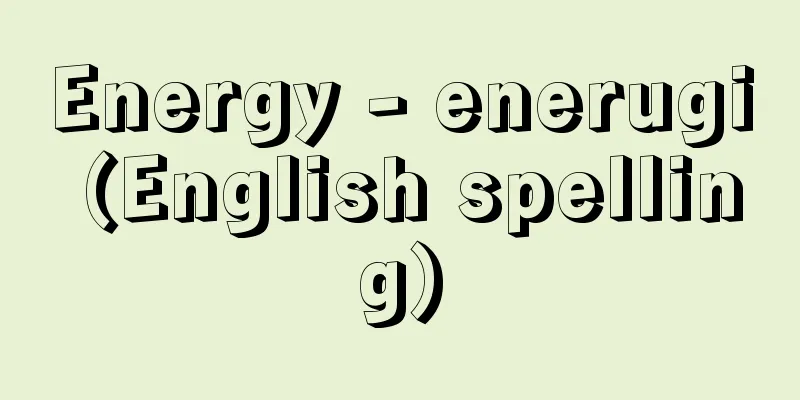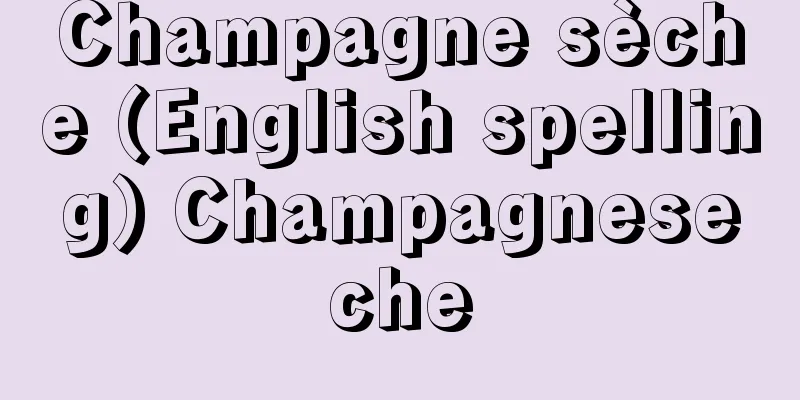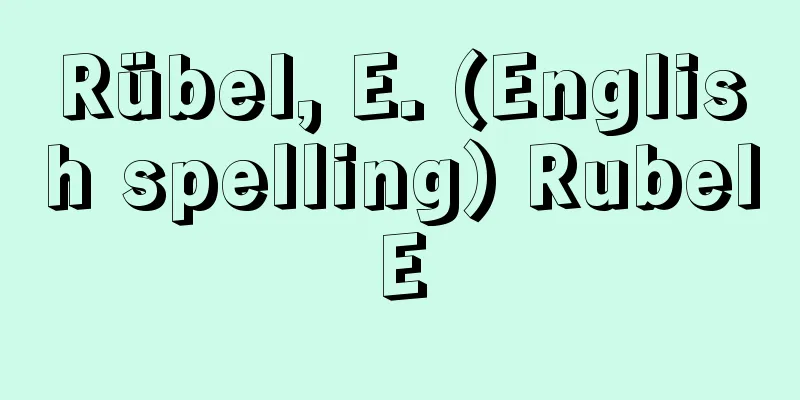Energy - enerugi (English spelling)

|
In general, when an object is in a state where it can do work on other objects, that object is said to have energy. No physical system can continue to do work indefinitely without interacting with the outside world. This is a fundamental principle taught by experience and is called the "principle of the impossibility of the first kind of perpetual motion machine." Here, the word "work" is used in a sense specific to physics. When one physical system A exerts a force F on another system B, moving the point of application of force a distance l in the direction of the force, it is said that A has done work on B equal to Fl . If the point of application of force moves in a direction that forms an angle θ (theta) with the force, it is said to have done work equal to Fl cosθ. If a person walks 5 meters up a slope that forms an angle α (alpha) with the horizontal plane while hanging a load with a force of 9.8 newtons (the force that acts on a 1 kilogram object and causes an acceleration of 1 m/s2 is called 1 newton. A newton is expressed in N), the direction of the force and the direction of movement form an angle of 90°-α, so the work done by this movement is 9.8N x 5m x sinα = 4.9 sinαN・m [Hiroshi Ezawa] Various energiesMechanical Energy Let's say that physical system A is an object of mass m , traveling to the right in zero gravity space at speed v . If it collides with physical system B (also an object of mass m ) and pushes B with a constant force F , then in reaction A will receive a constant force F to the left from B, decreasing its speed by F /m per unit time, and will come to a stop after a time Δt = v / ( F / m ) ( ). The distance A travels in this time is l = (1/2)( F / m ) ( Δt ) 2 = ( mv2 / 2)/ F. Next, let us consider an object m moving in a field where a vertically downward gravity mg acts, and let us consider object m in physical system A. If at a certain moment the height of mass m is z 0 and the velocity is vertically upward v 0 , then after a time t , the height is In general, when an object m moves from an arbitrary point P to an arbitrary point Q in a force field, if the work done by the field is determined only by the positions of the starting point P and the end point Q and does not depend on the path along the way, this field is said to be a field of conservative forces. Then, by fixing P and considering the work done by the field in the movement to Q as a function of the position r of Q, we can write it as -V ( r ). Then, if the velocity of object m when it reaches position r is v , [Hiroshi Ezawa] Heat Energy If an object m flying at a speed v jumps into water, the object will encounter resistance from the water and eventually come to rest. At this point, the temperature of the water will rise, and if you try an experiment, the amount of heat will increase as if the object had come into contact with a high-temperature heat source. An object with a high temperature is said to have heat, but its temperature can also be raised by supplying mechanical energy in this way. Heat can be distinguished from mechanical work in terms of the operation of increasing internal energy, but once it enters an object and becomes internal energy, the two cannot be distinguished. [Hiroshi Ezawa] Other EnergyIn addition to the above, there are many other known types of energy, such as wave energy such as sound waves and electromagnetic field energy. When we encounter a new phenomenon, we may have to consider a new type of energy in order to make the law of conservation of energy valid. Until now, the concept of energy has been expanded in this way to make the law of conservation valid. The actual content of the law of conservation of energy is to assert that this will always be possible in the future. Based on the law of conservation of energy alone, it seems possible to use all the oceans of the world as an energy source, and it would seem that something similar to a perpetual motion machine could be created. A device that takes heat from a single heat source, converts it all into work, and leaves no other changes behind, is called a perpetual motion machine of the second kind, but it is actually impossible to create one (second law of thermodynamics). On the other hand, all of mechanical energy can be converted into work. As such, different types of energy are more or less easy to use. This difference can be measured by entropy. Energy in a state of low entropy is orderly and easy to use, but energy in a state of high entropy has no direction, as exemplified by the chaotic movement of gas molecules, and is difficult to use. [Hiroshi Ezawa] Energy in the Microscopic WorldAccording to the theory of relativity, the energy E of a physical system appears as a mass of E / c 2 ( c is the speed of light, 3×10 8 m/s). An example of this is when the mass of a particle increases as its kinetic energy increases as its speed increases. Thus, the conservation of energy and the conservation of mass have been unified, and they are merely different ways of saying the same thing. The mass of an object when it is stationary is called rest mass, and the value obtained by multiplying it by c 2 is called rest energy. When an object is heated, its rest mass increases. However, even if the energy of a system increases by 1 joule, the mass only increases by 1.1×10 -15 kg, so in everyday phenomena, energy and mass are treated as separate entities that are unrelated. On the other hand, in nuclear physics, a conversion process occurs commonly in which an electron and a positron (total mass 9.1×10 -31 kg × 2) annihilate each other and turn into light (energy 1.6×10 -13 J). In this case, the mass does not disappear, and if you capture light in the container, you will see that the mass has increased, so it is incorrect to say that mass has turned into energy. Mass has simply changed form. When 92 protons (mass 1.673×10 -27 kg) and 143 neutrons (mass 1.675×10 -27 kg) combine, a uranium-235 nucleus is formed, but its mass is only 3.902×10 -25 kg, which is 3.2×10 -27 kg lighter than the sum of the masses of the protons and neutrons. This is because the energy of the protons and neutrons is lower when they are attracted to each other to form a nucleus than when they are separate, and this difference is called the binding energy. A similar phenomenon occurs with other atomic nuclei. When uranium-235 is hit with a neutron, it splits into two nuclei of similar size, and two or three neutrons are ejected at the same time. The total mass after this split is smaller than the mass of uranium-235. The energy released is equivalent to the difference Δ m , which is Δ mc 2 , and appears as the kinetic energy of the fission fragments and gamma rays. This is what is known as nuclear energy. However, even in this case, if we could put the whole thing in a container and measure its total mass, we would find that the mass remains the same before and after the fission. Nuclear energy is also released when light nuclei such as deuterium fuse together. When electrons combine with an atomic nucleus to form an atom, and when atoms combine to form a molecule, mass should decrease by the amount of binding energy, but this is usually not a problem since it is only about 1/100 million and 1/1 billion of the atom's mass, respectively. Light is emitted or absorbed by matter as packets of energy. These packets are called photons. The size of the packet is determined by the frequency of light, ν (nu), and is h ν, where h is the Planck constant, 6.6×10 -34 J・s. The energy of a photon is about 3.0×10 -19 J for red light (ν~4.5×10 14 s -1 ), while it is about 5.0×10 -19 J for violet light (ν~7.5×10 14 s -1 ). The reason why you will not get sunburned no matter how much you are exposed to infrared light, but you will get sunburned if you are exposed to ultraviolet light, is because the energy of the photons of the former is too small to cause the chemical reaction that causes sunburn. When an electron is confined to a region the size of an atom, it can only take on certain energy values. These specific values are called energy levels. For example, the energy level of an electron in a hydrogen atom is -2.18×10 -18 J/ n 2 ( n = 1, 2, ...). In general, it is impossible to accurately measure the time t and energy E of a physical system at the same time, and there is an uncertainty relationship between the respective errors Δt and ΔE : ΔE・Δt ≧ ħ ( ħ is the Planck constant h divided by 2π, i.e. ħ = h /2π). A notable example of this is the relationship between the lifetime τ (tau) of an atomic excited state and the natural width Δν of the corresponding spectral line: Δν = 1 /(2πτ). There is also a similar relationship between the lifetime τ of an elementary particle and its mass width: ΔMc2 〜ħ /τ. [Hiroshi Ezawa] The Establishment of the Concept of EnergyThe concept of energy is generally considered to have been established in physics in the mid-19th century, that is, in the 1840s, when Mayer, Joule, Helmholtz, and others proposed the law of conservation of energy. However, it was Rankine who first used the word "energy" to refer to all forms of energy known at that time, and it was not until the 1850s. The process of introducing the concept of energy prior to the above period was a process of clarifying the concept of energy as a category step by step, along with the establishment and development of mechanics. After the establishment of the conservation laws, mechanical energy, thermal energy, electromagnetic energy, etc. came to be understood in a unified manner, and furthermore, in the 20th century, the equivalence of mass and energy was proposed by the theory of relativity. In this way, the history of the development of physics can be said to be the history of the expansion and development of the concept of energy. And the law of conservation of energy has always been maintained as a more universal and fundamental law of nature, incorporating new forms of energy, and has remained so to this day. Leonardo da Vinci was the first to consider the amount of work, which gave us the beginnings of the concept of energy. He pointed out that the amount of work cannot be increased by using tools such as levers and pulleys. Da Vinci's work was a pioneer in the study of mechanics as physics. From the end of the 16th century to the beginning of the 17th century, Galileo and Kepler advanced their research on mechanics and the motion of celestial bodies. Galileo experimentally discovered that when an object falls, it gains the speed necessary to return to its original position. In response to this fact, Descartes was the first to provide a systematic explanation of energy, stating that "the same amount of 'motion' is always conserved in the universe" (Principles of Philosophy, 1644). In Descartes's "motion" is momentum in the modern sense, which states the "law of conservation of momentum." The Cartesians also stated that the "measure of force" is the "amount of motion" mv . In response, Leibniz argued (1686) that the "measure of force" is mv2 , based on the results of Galileo's experiments. This "force," which Leibniz called "vigor" (vis viva), is, in today's sense, kinetic energy itself, except for a factor of 1/2. Newton published his Principia in 1687, but he made no mention of the concept of energy in it, perhaps to avoid being embroiled in the confusion of the time regarding the concepts of force, momentum, and energy. The debate between the Leibnizians and the Cartesians over what the "measure of force" is continued until the middle of the 18th century. It was D'Alembert and others who settled the debate and clarified the significance of each quantity in mechanics, and later, T. Young was the first to use the word energy for mv2 (1807). In the 19th century, the spread of steam engines and the development of railways as a result of the Industrial Revolution throughout Europe became the first prerequisite for the establishment of the law of conservation of energy. Steam locomotives were seen by people at the time as a typical example of an energy conversion device. Thermodynamics was established within this. The second prerequisite was the establishment of modern chemistry and the development of biology, and energy conversion became an area of interest from the perspectives of chemistry and biology. The third was the establishment of electromagnetism. J. R. von Mayer, from his experience as a ship's doctor, noticed that the blood of sailors in tropical regions became redder, and from this he proposed the law of conservation of energy as a general principle (1842, 1845). Joule discovered Joule's law on the heating effect of electric current (1840), and was the first to determine the work equivalent of heat by measuring the amount of heat generated by electric current, using electromagnetic induction to generate electric current through the work done by a falling weight (1843). Furthermore, in 1845, he directly determined it in his famous impeller experiment. Following Mayer and Joule, it was Helmholtz (1847) who formulated the law of conservation of energy by giving an analytical expression. As described above, through the proposal and establishment of the law of conservation in a clear form throughout the 1840s, and through the emergence and establishment of new sciences and technological fields from the late 19th century to the 20th century, the concept of energy came to occupy a position as a fundamental category not only in physics but in the entire natural science system. However, both Mayer and Helmholtz called energy "force" at the time. This seems to indicate that the problem mentioned above was still lingering. It was only after J. J. Thomson and Rankine that the word "energy" became established as a term. The law of conservation of energy was established during the rise of thermodynamics, and the law of conservation of energy is considered to be the first law of thermodynamics. In other words, it means the impossibility of the first kind of perpetual motion machine. The second law of thermodynamics was discovered as the law that governs the thermal efficiency of heat engines, which shows the impossibility of the second kind of perpetual motion machine and also brings up the concept of entropy. Thus, the establishment of thermodynamics as a science that governs the conversion and transfer of energy progressed in parallel with and supported by the technological development of heat engines. Around 1860, Maxwell systematized electromagnetism, and from the 1860s to the 1870s, the efforts of E. W. von Siemens, Gramm, and Artenek led to the practical application of generators as engines that convert mechanical energy into electrical energy, and in 1882-1883, the construction and operation of central thermal power plants by Edison (New York and London) positioned the use of electrical energy in a social form. This marked the beginning of the age of electricity. [Arakawa Hiroshi] "Physics Reader" edited by Tomonaga Shinichiro (1969, Misuzu Shobo)" ▽ "Elementary Physics Series 3: Energy and Heat" by Arimitsu Toshihiko (1989, Baifukan) ▽ "Modern Physics Explained through Perpetual Motion Machines" by Koyama Keita (1994, Chikuma Shobo) ▽ "Energy: Three Keys" by Arakawa Hiroshi (1996, Hokkaido University Press) ▽ "Introduction to Energy Engineering" by Ito Koichi, Ooka Gosami, Takeda Yoji, Katayama Koichi, and Machii Reihisa (1997, Corona Publishing) ▽ "Energy and Heat" by Okabe Yutaka and Dodera Tomonari (1998, The University of the Air Foundation) ▽ "Microscience and Energy" edited by the Atomic Energy Society of Japan (1999, Corona Publishing) ▽ "Introduction to Mechanical Systems Series 10" by Fujita Hideomi and Kato Seizo Thermal Energy Systems (1999, Kyoritsu Shuppan) ▽ Encyclopedia of Energy, edited by Kaya Yoichi, Suzuki Hiroshi, Nakagami Hidetoshi, Nishihiro Yasuteru, Murata Minoru and Mori Nobuaki (2001, Maruzen) ▽ Iwanami Lecture Series on the Fundamentals of Modern Engineering 5: Energy Theory, by Fujii Yasumasa and Kaya Yoichi (2001, Iwanami Shoten) ▽ Energy and Electromagnetic Fields, by Abe Ryuzo (2002, Shokabo) ▽ Quantum Mechanics 1 and 2, by Ezawa Hiroshi (2002, Shokabo) ▽ What is the Theory of Relativity?, by Ezawa Hiroshi (2005, Nippon Hyoronsha) ▽ "Introduction to Quantum Energy Engineering, by Masakuni Narita (2003, Gendai Kogakusha)" ▽ "How the Laws of Physics Were Discovered, by R.P. Feynman, translated by Hiroshi Ezawa (Iwanami Gendai Bunko)" ▽ "My Theory of Energy, by Ryo Ikeuchi (Bunshun Shinsho)" [References] | | | | | | | | | | | | | | | | | | | | | | | | | | | | | | | | | | | | | | | | |If a person walks 5m up a slope with an angle of α while carrying a load of 9.8N (Newtons) ©Shogakukan "> Work in Physics (Figure A) In a gravity-free space, when object A with mass collides with object B at high speed ©Shogakukan "> Mechanical Energy (1) [Figure B] When an object moves in a field where gravity acts vertically downward ©Shogakukan "> Mechanical Energy (2) [Figure C] When an object plunges into water at high speed © Shogakukan "> Heat Energy (Figure D) Source: Shogakukan Encyclopedia Nipponica About Encyclopedia Nipponica Information | Legend |
|
一般に、物体が他の物体に対して仕事をすることができる状態にあるとき、その物体はエネルギーをもっているという。どんな物理系でも、外界となんの交渉ももたずに、限りなく仕事をし続けることはできない。これは経験の教える大原理であって「第1種永久機関の不可能の原理」とよばれる。ここで「仕事」ということばは物理学に特有の意味で使われている。 一つの物理系Aが他の系Bに力Fを及ぼして着力点を力の方向に距離lだけ動かしたとき、AはBにFlだけの仕事をしたという。もし着力点が力と角θ(シータ)をなす方向に動いた場合にはFlcosθだけの仕事をしたという。人が9.8ニュートン(1キログラムの物体に作用して1m/s2の加速度を生じさせる力を1ニュートンという。ニュートンはNで表す)の力で荷物をぶら下げて水平面と角α(アルファ)をなす斜面を5メートル歩いたとすれば、力の方向と移動の方向とは90゜-αの角をなすから、この移動では [江沢 洋] いろいろなエネルギー力学的エネルギー質量mの物体を物理系Aとし、これが無重力の空間を速さvで右向きに走っているとする。これが物理系B(同じく質量mの物体)に衝突し、Bを一定の力Fで押していくなら、その反作用としてAはBから左向きに一定の力Fを受け、速さを単位時間当りF/mずつ減じて、時間Δt=v/(F/m)ののちには止まってしまう()。この時間にAが走る距離は 次に、物体mが鉛直下向きの重力mgが働く場を運動するとして、ここでも物体mを物理系Aにとる。ある瞬間に質点mの高さがz0、速度が鉛直上向きにv0であったとすれば、時間tののちには、高さは 一般に、物体mが力の場の中を任意の点Pから任意の点Qまで移動するとき、場のする仕事が始点Pと終点Qとの位置のみで定まって途中の経路によらないとき、この場は保存力の場であるという。そしてPを固定し、Qまでの移動で場がする仕事を、Qの位置rの関数とみて-V(r)と書く。そうすると、物体mが位置rにきたときの速度をvとして [江沢 洋] 熱のエネルギー速度vで飛んできた物体mが水の中に飛び込んだとすると、物体は水の抵抗を受けてやがて静止する。このとき水の温度が上がり、実験してみると、あたかも高温の熱源に接触させて熱量 温度の高い物体は熱をもつというが、温度はこのように力学的エネルギーの供給によっても上げることができる。内部エネルギーを増す操作のうえからは熱を力学的仕事から区別できるが、いったん物体の中に入って内部エネルギーとなってしまえば両者の区別はできない。 [江沢 洋] その他のエネルギーエネルギーには以上にあげたもののほか、音波などの波動のエネルギーや電磁場のエネルギーなど多くの種類が知られている。新しい現象に出会えば、エネルギー保存則を成り立たせるために新しい種類のエネルギーを考えねばならなくなることもある。これまでエネルギーの概念は、このようにして保存則を成り立たせるように拡張されてきた。今後もつねにこれが可能であるという主張をするのがエネルギー保存則の実質的内容である。 全世界の海洋をエネルギー源として利用することはエネルギー保存則だけからは可能であるようにみえ、したがって永久機関に近いものがつくれそうに思われる。このように、一つの熱源から熱をとり、その全部を仕事に変え、それ以外になんの変化も残さないようにする装置を第2種永久機関とよぶが、それをつくることは実際は不可能である(熱力学第二法則)。他方、力学的エネルギーの場合はその全部を仕事に変えることができる。このようにエネルギーには種類により利用しやすさに差がある。その差はエントロピーで測ることができる。エントロピーの低い状態にあるエネルギーは秩序だっていて利用しやすいが、エントロピーの高い状態のエネルギーは、気体分子の乱雑な運動に代表されるように方向性がなく、利用しにくい。 [江沢 洋] 微視的世界におけるエネルギー相対性理論によれば、物理系のエネルギーEはE/c2だけの質量として現れる(cは光速3×108m/s)。粒子の速度が増すと運動エネルギーの増加に伴って質量が増すのは、その例である。こうしてエネルギーの保存則と質量の保存則は統一され、同じことを別の表現で述べているにすぎなくなった。物体が静止しているときの質量を静止質量とよび、それにc2を掛けた値を静止エネルギーという。物体を熱すれば静止質量が増す。しかし、系のエネルギーが1ジュール増しても質量は1.1×10-15kgしか増さないので、日常の現象ではエネルギーと質量は無関係な別ものとして扱われる。他方、核物理的な現象では電子と陽電子(質量の合計9.1×10-31kg×2)が対(つい)消滅して光(エネルギー1.6×10-13J)に変わるといった転化過程が普通におこる。この場合にも質量が消えるわけではなく、光を容器にとらえれば質量がそれだけ増しているのがわかるはずで、質量がエネルギーに変わったというのは正しくない。質量が姿を変えただけである。 陽子(質量1.673×10-27kg)92個と中性子(質量1.675×10-27kg)143個が結合するとウラン235の原子核ができるが、その質量は3.902×10-25kgしかなく、陽子と中性子の質量の和より3.2×10-27kgも軽い。これは、陽子と中性子はばらばらにいるときより、互いに引き合って原子核をつくっているほうがエネルギーが下がるからであり、その差を結合エネルギーという。同様のことは他の原子核でもおこっている。ウラン235は中性子でたたくと、大きさが同じくらいの二つの核に分裂し、同時に2個または3個の中性子が飛び出す。この分裂後の質量の総計はウラン235の質量より小さい。その差Δmに相当してΔmc2だけのエネルギーが解放され核分裂破片の運動エネルギーやガンマ線として現れることになる。これがいわゆる核エネルギーである。しかし、この場合にも全体を容器に収めて全質量を測ることができたとすれば、核分裂の前後で質量は変わらないことがわかるはずである。核エネルギーは重水素のような軽い核が融合するときにも解放される。 原子核に電子が結合して原子をつくるとき、また原子が結合して分子をつくるときにも結合エネルギー分だけ質量が減るはずであるが、それぞれ原子の質量の1億分の1、10億分の1程度にすぎないので普通は問題にならない。 光はエネルギーのかたまりとして物質により放出または吸収される。このかたまりを光子という。そのかたまりの大きさは光の振動数ν(ニュー)で決定しhνである。ただしhはプランク定数6.6×10-34J・sである。光子のエネルギーは赤い光(ν~4.5×1014s-1)では3.0×10-19J程度であるのに対し、紫色の光(ν~7.5×1014s-1)では5.0×10-19J程度になる。赤外線にいくら当たっても日焼けしないが紫外線に当たると日焼けするのは、前者の光子のエネルギーが、日焼けの化学反応をおこすには小さすぎるためである。 電子が原子くらいの大きさの領域に閉じ込められると特定のエネルギーの値しかとれなくなる。その特定の値をエネルギー準位とよぶ。たとえば、水素原子の電子のエネルギー準位は 一般に一つの物理系について時刻tとエネルギーEを同時に正確に測ることは不可能で、それぞれの誤差Δt、ΔEの間に不確定性関係ΔE・Δt≧ħ(ħは、プランク定数hを2πで割ったもの。つまりħ=h/2π)がある。その著しい例は、原子の励起状態の寿命τ(タウ)と対応するスペクトル線の自然幅Δνとの関係Δν=1/(2πτ)である。また素粒子の寿命τと質量の幅との間にも同様の関係ΔMc2~ħ/τがある。 [江沢 洋] エネルギー概念の成立エネルギー概念が物理学において確立されたのは、通例では19世紀なかば、すなわち1840年代のマイヤー、ジュール、ヘルムホルツらによるエネルギー保存則提起の時期とされている。ただし、当時知られる限りのすべての形態のエネルギーに対して、ことばとして初めてエネルギーとよんだのはランキンであり、1850年代に入ってからである。以上の時期に先だつエネルギー概念導入の過程は、まさに力学の成立・展開とともに、カテゴリーとしてのエネルギー概念を一歩一歩明確化させる過程として進められた。その後、以上の保存則成立期以降において、力学的エネルギー、熱エネルギー、電磁気的エネルギーなどが統一的にとらえられるようになり、さらに、20世紀に入って相対論により質量とエネルギーの同等性が提起される。このようにみてくると、物理学の発達の歴史は、まさに、エネルギー概念の拡大・展開の歴史でもあるということができよう。そしてエネルギー保存則は、つねに、新たな形態のエネルギーをそのなかに包摂しながら、より普遍的かつ基本的な自然法則として維持され、今日に至っている。 歴史上、最初に「仕事の量」を問題にすることで、エネルギー概念への端緒を与えたのはレオナルド・ダ・ビンチであり、てこ、滑車などの器具を用いた場合、仕事の量を増加させることはできないと指摘した。ダ・ビンチの業績は物理学としての力学研究の先駆ともなるものであった。16世紀末から17世紀初めにかけてガリレイ、ケプラーによる力学、天体運動に関する研究が進む。物体が落下に際し、もとの位置に戻るのに必要な速度を得るという事実は、ガリレイにより実験的にみいだされた。以上の事実に対して、「宇宙のなかにつねに同じ量の『運動』を保存している」(『哲学原理』1644)と述べて、初めてエネルギーについての体系的な説明を与えようとしたのはデカルトである。デカルトにおけるこの「運動」は今日の意味では運動量であり、これは「運動量保存則」を述べている。そして、デカルト派は「力の測度」は「運動の量」mvであるとした。これに対してライプニッツは、「力の測度」はmv2であることをガリレイの実験結果に基づいて主張した(1686)。ライプニッツが「活力」vis vivaと名づけたこの「力」は、今日の意味では1/2の係数を別にして運動エネルギーそのものである。ニュートンは1687年『プリンキピア』を世に出しているが、力、運動量、エネルギー概念に関する当時の混乱に巻き込まれることを避けるためか、そのなかでエネルギー概念については何も述べていない。「力の測度」は何であるかをめぐってのこのライプニッツ派―デカルト派の論争は18世紀なかばころまで続く。この論争に決着をつけ、力学におけるそれぞれの量の意義を明らかにすることは、ダランベールらによってなされ、のち、T・ヤングはmv2に対して初めてエネルギーということばをあてた(1807)。 19世紀に入って、産業革命の全ヨーロッパ的展開による蒸気機関の普及と鉄道の発達は、エネルギー保存則成立への第一の前提となった。蒸気機関車はエネルギー転換装置の典型として当時の人々の目に映った。そのなかで熱力学が成立する。第二の前提条件は近代化学の成立、生物学の展開であり、化学、生物学の面からエネルギー転換に関心が寄せられた。第三は電磁気学の成立である。J・R・von・マイヤーは、船医としての経験から、熱帯地方では船員の血液が赤みを増すことに気づき、そこから、一般原理としてエネルギー保存則を提起した(1842、1845)。ジュールは電流の熱作用についてのジュールの法則をみいだし(1840)、分銅の落下による仕事で電磁誘導を利用して電流を生じさせ、その電流による発生熱量の測定から、熱の仕事当量を初めて定めた(1843)。さらに、1845年には有名な羽根車の実験で直接それを求めている。マイヤー、ジュールに次いで、エネルギー保存則の解析的表現を与えて定式化したのはヘルムホルツである(1847)。以上のように、1840年代を通じての明確な形での保存則の提起・確立によって、さらに19世紀後半から20世紀にかけての新たな諸科学・技術学の登場と成立過程を通じて、エネルギー概念は物理学のみならず、全自然科学体系にとっての基本カテゴリーとしての位置を占めることになる。しかしながら、当時はマイヤーもヘルムホルツもエネルギーを「力」とよんでいた。これは、先に述べた問題がなお尾を引いていたとみられる。エネルギーの語がことばとして定着するのは、J・J・トムソン、ランキン以降である。 以上のエネルギー保存則の成立期は同時に熱力学の興隆期であり、エネルギー保存則は熱力学第一法則としてそのなかに位置づけられる。いいかえれば第1種永久機関の不可能性を意味するものとなる。そして、熱機関の熱効率を規定する法則として熱力学第二法則がみいだされ、これは第2種永久機関の不可能性を示すとともに、エントロピー概念を提起する。こうしてエネルギーの転換と移動を規定する科学としての熱力学の成立は、熱機関の技術的展開と並行し、それに支えられて進められる。1860年前後にマクスウェルにより電磁気学の体系化が行われ、1860年代から1870年代にかけて、E・W・von・ジーメンス、グラム、アルテネックらの努力で、力学的エネルギーを電気的エネルギーに転換する機関としての発電機が実用化され、1882~1883年、エジソンによる中央火力発電所の建設・操業開始(ニューヨーク、ロンドン)は電気エネルギー利用を社会的な形で位置づけた。ここに電気の時代が始まる。 [荒川 泓] 『朝永振一郎編『物理学読本』(1969・みすず書房)』▽『有光敏彦著『初等物理シリーズ3 エネルギーと熱』(1989・培風館)』▽『小山慶太著『永久機関で語る現代物理学』(1994・筑摩書房)』▽『荒川泓著『エネルギー・3つの鍵』(1996・北海道大学図書刊行会)』▽『伊東弘一・大岡五三実・武田洋次・片山紘一・町井令尚著『エネルギー工学概論』(1997・コロナ社)』▽『岡部豊・堂寺知成著『エネルギーと熱』(1998・放送大学教育振興会)』▽『日本原子力学会編『ミクロ科学とエネルギー』(1999・コロナ社)』▽『藤田秀臣・加藤征三著『機械システム入門シリーズ10 熱エネルギーシステム』(1999・共立出版)』▽『茅陽一・鈴木浩・中上英俊・西広泰輝・村田稔・森信昭編『エネルギーの百科事典』(2001・丸善)』▽『藤井康正・茅陽一著『岩波講座現代工学の基礎5 エネルギー論』(2001・岩波書店)』▽『阿部龍蔵著『エネルギーと電磁場』(2002・裳華房)』▽『江沢洋著『量子力学1、2』(2002・裳華房)』▽『江沢洋著『相対性理論とは?』(2005・日本評論社)』▽『成田正邦著『量子エネルギー工学入門』(2003・現代工学社)』▽『R・P・ファインマン著、江沢洋訳『物理法則はいかにして発見されたか』(岩波現代文庫)』▽『池内了著『私のエネルギー論』(文春新書)』 [参照項目] | | | | | | | | | | | | | | | | | | | | | | | | | | | | | | | | | | | | | | | | |人が9.8N(ニュートン)の力で荷物を持って角度αの斜面を5m歩いた場合©Shogakukan"> 物理学における仕事〔図A〕 無重力空間で、質量の物体Aが速さで物体Bに衝突した場合©Shogakukan"> 力学的エネルギー(1)〔図B〕 物体が、鉛直下向きの重力が働く場を運動する場合©Shogakukan"> 力学的エネルギー(2)〔図C〕 物体が速度で水中に飛び込んだ場合©Shogakukan"> 熱のエネルギー〔図D〕 出典 小学館 日本大百科全書(ニッポニカ)日本大百科全書(ニッポニカ)について 情報 | 凡例 |
Recommend
The Tale of the Sheep
Also called the "Spring and Autumn Annals: Go...
Nawa [town] - Nawa
A former town in Saihaku District, western Tottori...
Pragmatism - Pragmatism
A philosophy that was born in the United States at...
Lilienthal, DE
...The headquarters is in Knoxville, Tennessee. D...
Gymnocorymbus ternetzi (English spelling) Gymnocorymbusternetzi
…It is similar to the neon tetra, but has a red b...
Impedance measurement
...The three-phase power measurement is performed...
protocol
…Most metazoans are divided into protocoelomates ...
Divorce by mutual consent - Kyogirikon
A divorce by mutual consent between husband and wi...
Kanada [town] - Kanada
An old town in Tagawa County, in the north-central...
Child - Chigo
The word's origin is from the word chigo (inf...
Bishamon no Honji - Bishamon no Honji
The title of a sekkyobushi song. The original work...
Mr. Akimoto
Lord of the Kozuke Tatebayashi Domain. In the 13th...
Katakura Kanetaro
Year of death: February 13, 1917 Year of birth: No...
Coast cotton tree
...It cannot survive winter outdoors in mountaino...
Asian skunk cabbage - Asian skunk cabbage
A perennial plant of the Araceae family (APG clas...







![Fuse [Village] - Fuse](/upload/images/67ccb52016e31.webp)

